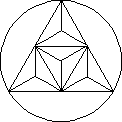Scale structures & asymmetric symmetries
Scale structures result from the outworkings of Universal interconnectedness. There exist resonant points and divisions of wholes and these generally reflect an integrative process in which every part contributes to the emergence of 'resonant forms'.
Sometimes a new perspective or paradigm shift is necessary in order to recognise an often hitherto-covert natural rationalism or scale structure (as will be demonstrated later in this document). Such forms may entail asymmetric but no-less 'rational divisions'. The resonances are like harmonics on a vibrating string—the harmonic positions (scale structures) are not independent of the length of the string but in fact dependent upon it. Scale structures as discussed in this text are thus generally dependent (in an integrative sense) and may be seen as the emergent outworkings and forms within systems (be they linear or nonlinear).
Introduction to scale structures (from a musical perspective)
Scale structures often simultaneously entail symmetric and asymmetric qualities. As I am invoking the term "scale" in the musical sense, music is a logical place to look for a good example of this. Take, for example, the ubiquitous major diatonic scale of western music and JS Bach's division of an octave into twelve equally-spaced semitones. [On the modern-day keyboard these semitone (half-tone) intervals are played sequentially and ordinally by pressing the next most adjacent key in the upward or downward direction and irrespective of whether it be a black or white key.]
Curiously and incredibly, the 'major scale' of classical and popular music simultaneously combines both symmetric and asymmetric attributes:
- There is an asymmetry in the sequence of intervals between the eight notes of the octave that make up a major scale and it is this sequence that defines a scale as "major". The intervals (from the bottom of the octave to the top) must proceed thus: tone, tone, semitone, tone, tone, tone, semitone. See animation below. (Note also there are only seven intervals between the eight notes of an octave.)
- There are also various symmetries, one of the most obvious of which is the interval of the octave itself (which divides a vibrating string in exactly the ratio 1:2 and which sounds to the human ear like the very 'same' note except of higher or lower pitch —a remarkable neurophysiological 'coincidence'. Why?
- There are twelve equally-spaced semitones (a form of symmetry) which span the interval of the octave. And yet in the tonal classical tradition (as also used in popular music) most scales employ only eight of these twelve possible 'notes' (hence the name, octave) and in asymmetric sequence. The different diatonic scales based on different starting notes are commonly referred to as key signatures.
| back to top |
next > |
